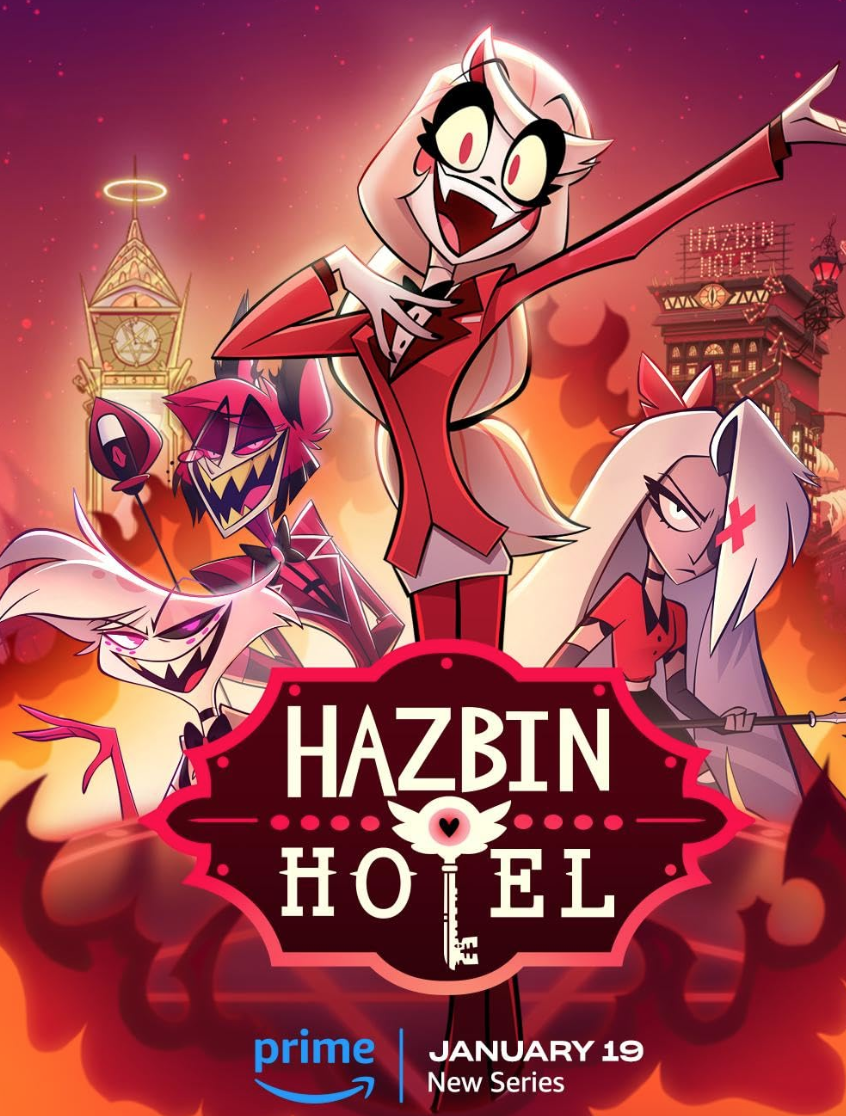Photo: Hazbin Hotel Poster-Source:IMDb.png
After years of anticipation, “Hazbin Hotel,” which first began with its YouTube pilot back in 2019, has finally wrapped up its first season on Prime Video. With all the buzz surrounding the newly-produced indie animation from creator Vivienne Madrano, and production studios A24 and Bento-Box, the question remains: Was “Hazbin Hotel” worth the wait?
First, a synopsis of the plot. Set against the backdrop of Hell, “Hazbin Hotel” follows Charlie Morningstar, the optimistic, happy-go-lucky daughter of Lucifer, trying to help redeem damned souls in order to get them into Heaven. This isn’t only because of Charlie’s kind and altruistic nature, but also because of the “Extermination,” an annual event where certain angels, dubbed “Exorcists,” fly down from Heaven to eliminate every “Sinner” they can find as a brutal form of population control over Hell. Hoping to nullify this, Charlie tries to recruit guests for the hotel to prove that Sinners can be redeemed. However, things take a turn for the worse as Adam, the first human-turned-angel and leader of the Exorcists, mocks and belittles Charlie for her beliefs about redemption, and moves up the next Extermination by six months just to spite her. With the clock ticking, Charlie rushes to find a Sinner to redeem to prove her solution works to the heavenly host.
The good news is that “Hazbin Hotel” excels at many things: its premise is original and puts an intriguing spin on Christian theology, Madrano’s art style is bursting with details and exudes an air of 2000s animation, the worldbuilding and characters are engaging and the soundtrack is remarkable.
Originality is a quality that can make any product of the creative process truly memorable, and while theologians and artists of all stripes have been depicting Heaven and Hell for centuries, Vivienne Madrano has created something entirely her own. It would have been enough to simply write a story about Heaven & Hell and filter it through the medium of animation, but by utilizing dark humor and the creator’s clear adoration with Broadway musicals, “Hazbin Hotel” stands apart from other contemporaries focused on the same subject matter, such as “Good Omens” (2019).
However, while the show’s writing is exceptional, the pacing of “Hazbin Hotel” is far too rapid, with the plot in such a rush to get to the finale that it creates a sense of whiplash. One such example is in the case of Charlie’s girlfriend, “Vaggie,” who could have used some more time and re-writing. This can be excused however, as each episode is just under thirty minutes in length, with only eight episodes in the entirety of the first season. Hopefully, the second season of “Hazbin Hotel” will flesh out its cast of characters more and ease off the gas, if only a little.
As with any product of animation, having an aesthetically unique art style is vital to ensuring the final result stands out enough to warrant the viewer’s attention. It is here that “Hazbin Hotel” demonstrates its impressive artistic direction. Each frame of animation is so detailed that it warrants repeated viewings just to notice what’s happening outside the center of the frame. Further, the characters that make up the cast each have their own design that helps them stand out in every scene. “Hazbin Hotel”’s animation style displays influences from earlier western animation, specifically that of the 2000s; “Invader Zim” is a clear example of influence on Madrano’s style. The evolution from amateur YouTube animation to the sleek, albeit streamlined, designs seen in the show’s final product displays the increased production values the Hazbin Hotel has, thanks to A24 and Bento-Box, making the result all the stronger.
That isn’t to say the quality of the animation is flawless. Thanks to the uniformed nature of the character models, they lose some of the charm that was present in the pilot. Granted, this is a small issue, and thankfully doesn’t become noticeable enough to distract most audiences.
Animation, being a medium separate from live-action film, can often live and die by the quality of its voice acting. When audiences and critics first heard that the cast of the show would use completely new voice actors, including Broadway talent, it created some fears that the new voice actors on offer wouldn’t be able to fill the vacuum left behind. Happily, the new cast more than excel at their performances, making it next to impossible to find one gripe about any of the voice actors. Amir Talai and Blake Roman are the most notable in their roles of Alastor and Angel Dust, respectively. Roman brings his Broadway experience to the table in the show’s musical numbers, with the biggest example being “Poison.” Concurrently, Amir Talai’s performance practically steals the show in every scene he is in, such as in episode six, “Dad Beat Dad,” where his character quickly develops an antagonistic relationship with Lucifer.
Most of all though, “Hazbin Hotel”’s greatest strength lies in its soundtrack, courtesy of Sam Haft, Andrew Underberg, Evan Alderete and Cooper Smith Goodwin (YouTuber Gooseworx). Almost every single episode features songs that blend genres, including musicals, rock, pop, duets, jazzy show tunes and even niche sub-genres like electro-swing. The music carries the entire production, with numbers that help capture the mood of each scene, leaving memorable, lasting performances that display the composer’s incredible skill and talent. It would be a gross oversight if this animated show didn’t win some kind of award for its soundtrack.
With “Hazbin Hotel”’s troubled production process from YouTube animation, to being a full-fledged animated TV series, it became difficult to say whether the show would live up to the expectations that surrounded it. Thankfully, the effort put into “Hazbin Hotel” has more than paid off, with the show trailblazing a new golden age for indie animation!
Kelly Baker is an alumnus of West Chester University of Pennsylvania.

